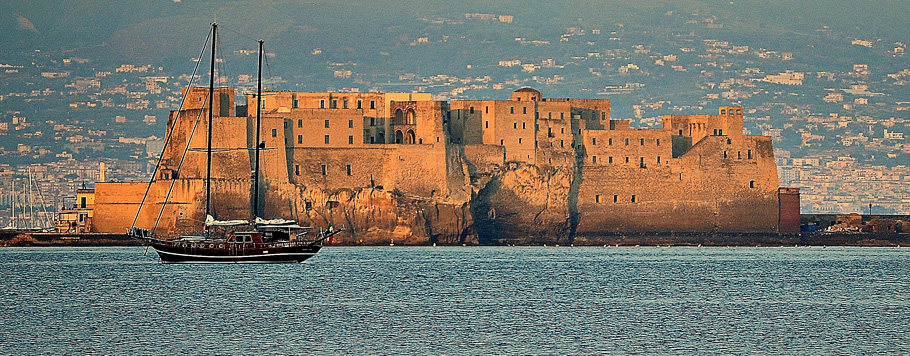 un progetto di
un progetto di 
Sul roccioso isolotto di Megaride, a pochi metri dalla riva, sorge imponente il Castel dell'Ovo, così denominato secondo la leggenda che vuole che Virgilio avrebbe nascosto un uovo “protettore” all'interno di una gabbia nei sotterranei.
L'isolotto fu fortificato con la costruzione del castello durante il Ducato bizantino, almeno dal 1128, per far fronte ai pericoli di invasione. Con l'arrivo dei Normanni, l'antica fortezza venne ampliata e re Ruggiero II ne fece la propria sede e vi riunì il Parlamento. Con gli Svevi il castello ebbe ruolo di reggia ma anche di prigione di Stato. Lavori imponenti furono eseguiti durante il regno di Carlo I d'Angiò quando vi furono ospitati il Tribunale della Camera Regia e l'Erario dello Stato. Seguirono ad inizio del '400 le lotte tra Angioini ed Aragonesi ed il castello fu preda ora dell'una ora dell'altra famiglia. Il vincitore, Alfonso V d'Aragona, ristrutturò ulteriormente il castello arricchendo il palazzo reale, ripristinando il molo, potenziando le strutture difensive e abbassando le torri.
Assunse la forma attuale di cittadella bastionata che incute rispetto nel '500 quando il castello fu massicciamente ristrutturato. In seguito, durante il regno dei Viceré spagnoli e successivamente dei Borbone fu fortificato ancor più con batterie e due ponti levatoi e venne utilizzato nuovamente come prigione.
Oggi è adibito a sede di mostre e convegni.
Castel dell'Ovo stands on the islet of Megaride, two rocks linked by a large bridge. Colonists from Cumae (their origins being partly Greek) landed on this islet towards the middle of the 7th century BC and eventually founded the city of Partenope (or at least the first nucleus of it) on Mount Echia. In 1949 the necropolis of the city was found in Via Nicotera 10, where they were digging to lay the foundations of a new building in replacement of the previous one which had been bombed during the Second World War. The famous villa of Lucius Licinius Lucullus was built on the islet and Mount Echia, in the 1st century BC, during the Roman domination. The villa was magnificent, with gardens and fountains extending as far as the present Town Hall Square, as we can see from a structure brought to light during recent excavations beneath Castelnuovo. Very few signs of this villa remain; there are parts of columns from the so called "Columns Hall", which, during the first half of the Middle Ages, was used as a refectory of one of the convents built on the islet, and the remains of a nymphaeum on the terrace of Mount Echia.
Contatti
Castel Dell'Ovo
Via Eldorado, 3
80132 Napoli
Informazioni generali
E-mail: casteldellovo@comune.napoli.it
Web: comune.napoli.it